Transcription
DELANCEY STREET FOUNDATION:
A Process of Mutual Restitution
By: Mimi Silbert, Ph. D
President
*chapter from the book: SELF HELP
REVOLUTION
Edited by: Frank Riessman. Ph. D
Alan Gartner, Ph. D.
Copyright © 1984 Human Sciences Press, Inc
72 Fifth Avenue, New York, New York 10011
Deborah was 27 when she came to Delancey Street. A heroin addict at 12, a street prostitute at 13, she had been "cured" by over a dozen other programs and hospitals; she had spent five years in prison, and lived through numerous horrors, like having her baby drown in the bathtub while she turned her back on him to take a fix; she had tried to kill herself three times. Deborah left school in the ninth grade, was unskilled, and stated that she felt good "only with men and drugs". She came to Delancey Street only to "beat a prison case", promised (as all residents must) to stay two years, and intended (as all residents do), to stay only a few months to clean up and then leave.
Deborah stayed at Delancey Street out of fascination and manipulation: seeing people she knew as losers on the street, living in San Francisco's most exclusive residential area, well-groomed, well-dressed, she believed "there must be something 'dirty' going on at Delancey Street", and planned to stay long enough to get in on it. Before she realized it, she had internalized enough of the process she had been "imitating", that she began to rethink her old values and attitudes. She worked long enough and hard enough in the tightly structured community to see herself gaining skills and work habits. She had been confronted about herself often enough by her peers that she had now come to take responsibility for what she had done, and to exert some control over what she was doing right now. In short, knowing secretly that she would always stay a dope fiend, Deborah began to believe that she could - and would - change. And then she stayed at Delancey Street for the right reasons: to redo her life.
Three and one half years later, Deborah graduated from Delancey Street. She had an A. A. in Business and a well-paying job as a sales manager in a nationally known firm. She traveled for the firm, received supervisory training, and was a respected employee. Aside from her career and well-balanced personal life, Deborah set up a program for paraprofessional volunteers to work with adolescent girls returning to the community from mental hospitals. Deborah manages to come back to Delancey Street often to serve as a role model for the new women residents who are coming in, giving their word to stay two years, and privately planning to stay a few months, clean up, and leave...
Delancey Street Foundation is described as a residential treatment center for ex-addicts, alcoholics, convicts and prostitutes. The Foundation prefers to consider itself a recycling center, where those whom the system has defines, and who, indeed, have defined themselves as "society's garbage", can live, work, and learn together to return to society as productive citizens. Delancey Street has no staff of experts, professional psychologists or professional ex-drug addicts; the "therapy" depends upon our processes rather then "professionals". While by goal, Delancey Street is defined as a drug/alcohol/crime treatment program, in its processes, Delancey Street has less in common with funded, staffed treatment programs, than it does with large families or small neighborhoods. In families and old-fashioned neighborhoods, as in Delancey Street, members are dependent upon one another as they grow to develop an identity and an independence which allow them to enter the world-at-large alone, while still maintaining a sense of continuity with the family and the old neighborhood. Delancey Street's self-help process of growth and change and interdependence are applicable to any group of varied goals who choose to pool their resources, rely on their own strengths, and help one another develop.
The residents of the Delancey Street Family, like Deborah, are the hardcore helpless: those traditionally considered by society to be "un-amenable to treatment". Over 85 percent have been heroin addicts for an average of ten years; over 60 percent are poly drug abusers; over 40 percent are alcoholics. *The average resident at Delancey Street has served an average of seven years in prison and has been returned to prison between three and four times. S/he comes from a poor family, reads and writes at a sixth grade level, is unskilled, and has never held a steady job for as long as a year. Given the population, the attrition rates are unexpectedly low. The overall is 35%; of these, the majority leaves in the first few months of their stay. Of those who leave, some return to Delancey Street and do well the second time. Some may survive well on the street; some go to prison; some die.
(*These statistics total over 100 percent because they reflect multiple abuses for each resident)
Over half of the people who come to Delancey Street are referred by the courts through pretrial diversion, as an alternative to prison, or as a condition of probation or parole. The others come in off the street. There is only one criterion for entry into Delancey Street: the person must ask for help him/herself. No payment is accepted. No requests from concerned parents or lawyers can substitute for the individual taking the first step of accepting the responsibility for his/her own life.
Social problems like drug addiction and crime are complex phenomena which involve the total interaction of individuals with the system. In our zeal for quick cures to these problems, however, we develop simple definitions. There are those of us who consider crime to be the result of an unjust and inequitable society. These people end to "kiss the buts" of the poor misunderstood criminal. The result, unfortunately, is legions of junkies and criminals who carry more guilt for one more con, and who, because they are stripped from the responsibilities of their pasts, are equally removed from the control of their futures. Conversely, there are those who consider crime solely the fault of the individual, be it through criminal inclination, biological defect, or psychological disease and personality disorder. These people tend to "kick the butts" of the criminal. But this response, while it engenders anger, bitterness and hatred, rather than manipulation and guilt, leaves the criminal as void of options as the other extreme. WE place people in prison, where, however horrible or humane the conditions, the inmate are stripped of all interactions with society; they are also stripped of all responsibility, and are maintained at the taxpayer's expense. Thus, they emerge with no sense of responsibility or personal power.
Delancey Street cuts through this dichotomy to stress the interaction of the individual with the social system. Delancey Street's philosophy is that the individual must take the responsibility for his own actions so that he can exert some control over himself and create some viable options. Only from a position where the individual has some personal power over their life, can they move to demand their due from society or work to change the inequities of its system.
Hundreds of people have graduated from Delancey Street with an overwhelming rate of success. Over three fourths of the graduates are currently thriving in the community, with lifestyles and occupations ranging from a deputy sheriff, a mortician, real estate brokers, and advertising executives to contractors, truckers who own their own companies, engineers, medical and dental technicians, and lawyers.
The Foundation takes its name name from the street in New York's Lower East Side where, at the turn of the century, Delancey Street came to symbolize the self-reliance of Old World immigrants who worked and earned their way into the mainstream of American life. In fact, the Intake Department is called "Immigration", for the people who come to Delancey Street are like immigrants to the American system. They have never learned to live legitimately and successfully within that system, and that is what Delancey Street teaches them. While this generation has been labeled the narcissistic "me generation", where people struggle not to impose their own valuers on others, Delancey Street stresses traditional values: the work ethic, the importance of self-reliance and the dignity of earning one's own way in the world, and helping others as a central means to feeling good about one's self. Unlike other organizations which develop alternative principles and lifestyles, Delancey Street prepares its residents to live effectively in the dominant American social culture. To "choose" to reject a society which has rejected them in a meaningless protest, for there are few alternatives. But the decision to work to change a system, in which they have numerous positive alternatives, is indeed a viable choice.
The philosophy of change at Delancey Street is based on what I call "mutual restitution". The residents gain the vocational, personal, interpersonal and social skills necessary to make restitution to the society from which they have taken illegally, consistently and often brutally, for most of their lives. In return Delancey Street demands from society access to the legitimate opportunities from which the majority of residents have been blocked for most of their lives. By living together and pulling resources, Delancey Street residents acquire enough strength and credibility that the demands to gain access to society's opportunities must be taken seriously. This process, of gaining the skills and abilities and self-concept necessary to make and receive social restitution, minimally requires two years. The average stay, prior to graduation from Delancey Street, is three and a half years.
In order to accomplish this process of mutual restitution, there is a constant training and education process which begins the day the new resident arrives. The first area of re-education is "school learning". Everyone who comes to Delancey Street is tutored in basic skills: reading, writing, and math, until they receive a high school equivalency certificate. After that, residents can go on to various forms of education. There are currently over 100 residents in colleges and professional schools. One resident, soon to be graduate, is now in his second year in medical school.
The second area is vocational training. Delancey Street maintains nine training schools which also serve as the businesses by which the Foundation earns its living. These training schools include a restaurant, a catering business, a moving and trucking school, terrarium and sand paining production and sales, furniture and woodwork production and sales, specialty advertising sales, antique care restoration, the operation of outdoor Christmas tree lots, and a print shop. Residents, who have traditionally been unemployable welfare cases, have started, worked, and managed these training school businesses so successfully that they are the Foundation's primary source of working capital.
Vocational training is accomplished in three phases. The first is in-house training, where the residents are trained to perform skills simply within the Foundation. The stress here is not only on learning basic skills, but on developing work habits and self discipline. When residents have mastered the basic skill, they move on to testing these skills in work performed through a Delancey Street company for people in the community. After they've achieved a level of competence there, they are ready to move on to the third phase, which is to get a job or business in the community, where they must work successfully for one to three months prior to graduation from Delancey Street.
Residents are caught in an ever-downward spiral of self-destructive acts which destroy not only themselves but others; this leads to guilt, which leads to self-hatred; which leads to more self-destructive acts. In order to break the cycle, it is imperative to interrupt it with some positive experiences. In the tightly structured environment of Delancey Street, residents who follow the rules cannot help but succeed. They achieve successes at work; because others are counting on them, they achieve successes with helping others, particularly those newer than themselves; they succeed in caring more for themselves in their personal habits; their cleanliness and clothing, for example. Rather than enshroud the negative self-concept with responses of support from others, residents replace the self-hate with self-respect by acting in such a way as to earn it ad earn as well positive reinforcements from others.
Every reward, from moving from a crowded dorm in to a semi-private room; or moving up a notch in one's job; or taking the responsibility and authority for more and more of one's decisions, must be earned through self-discipline, hard work, and caring for others as well as one's self.
At about six months we assume that the resident has achieved enough success and positive experiences to look at the past for the first time in his/her stay at Delancey Street. This is accomplished in a weekend-long marathon session called a Dissipation, which is geared to dissipate the guilt of past behaviors. Here the newer residents, guided by older residents, in groups of fifteen, review their past histories, reliving every act they have committed in the past; until they are able to rid themselves of the tremendous guilt which dominates their lives. The weekend is concluded with the older residents showing the newer residents how, in these past six months, they have proven themselves to be someone new, to be capable of something different. They now have a greater responsibility, because they've begun to see themselves for what they can be in the future.
The final area of education the Delancey Street stresses is one of the most critical: social or community training. Following the philosophy of restitution, Delancey Street residents, in addition to working, studying and playing games, are encouraged to help others in the community. Since Delancey Street opened, there have been large numbers of residents who have worked with senior citizens, escorting them to and from the bank, visiting homes, showing movies, presenting plays. Residents work with juveniles from poor areas, taking them on cookouts, on tours of the city, on tours of Alcatraz, and giving crime and drug prevention seminars. By using their own experiences, by showing that involvement with crime and drugs is by no means tough and glamorous, residents provide a realistic assessment and hence a viable diversion from crime.
Residents also do volunteer work with the handicapped and are engaged in police training. They help with fund raisers for the ballet and the opera. They are all encouraged to vote; and while, like any group, they don't accomplish full voting, several of the residents do go out and work for candidates or issues in which they believe. In essence, they work and donate their time and energy to improve the quality of American life.
Social problems often follow the medical model, but too many of them reflect only one style of medical model: that of cancer, say where the patient goes into hospital, the doctor operates and the patient is either a cure, if his disease is cut out successfully, or a failure if it isn't. The social problems of drug addiction and crime are more comparable to scarlet fever or malaria, where people are taken into a hospital. As soon as they have reached the point where they're able to stand on their feet, they take the sheets, boil them, and go down into the swamps because the disease is not one that lives inside the individual and can be cured within the individual. The disease breeds in the swamp and the swamp must be cleaned out or everyone will be re-infected. In our society, the uncared for old people, the social, economic and criminal injustices are all elements of the swamp. None of us is free until all of us have the choices and responsibilities which comprise real freedom. Who better to take responsibility for cleaning out the swamp than those of us who seem to be most prey to fall victim to the disease?
Therefore, at Delancey Street, although our statistics are extremely impressive, we consider it far more important to measure our success not simply by counting the number of individuals "cured", but by measuring the impact we have had on the swamp. Delancey Street, for example, started for the first Federal Credit Union by and for ex-convicts, where poor people get the money necessary to get started in some legitimate way in society. Delancey Street fought to get wine and beer licenses for ex-felons and for the right of ex-felons to practice law. Delancey Street fought to get ex-felons real estate licenses. Each of these has not only helped the individuals for whom Delancey Street secured the certificate but has helped hundreds of ex-felons for whom these many more opportunities are now open. Delancey Street has worked with the handicapped in their fight for civil rights. Delancey Street has fought for the rights of labor groups as well as for their responsibility to integrate their membership.
Perhaps one of the most difficult areas of education in Delancey Street has to do with educating the self. The majority of residents in Delancey Street have been labeled as "psychopaths" or "sociopaths", those who feel no remorse or guilt for their actions. In truth, Delancey Street residents are consumed and in fact paralyzed by guilt. For most of them the horrors of life in which they have been involved are so great, that he need to obliterate these memories is a life-saving defense. To come to grips with some of the actions they have perpetrated agaist. themselves and others before they have any positive experiences with which to mitigate the horrors could be a totally destructive process.
In the first few years of Delancey Street's growth, residents chose the area in which they wanted to be trained. However, the residents fell into the stereotyped job positions they assumed society held for them. The women chose paperwork jobs; the Blacks and Latinos primarily chose physical labor; and Anglo males picked sales. Now, every resident is briefly trained in one physical labor job; one sales-oriented job; and one paperwork job. After residents see they have abilities in areas beyond their stereotypic images, they can choose the field in which they want to make their careers.
Everyone in Delancey Street works, and no one, including the two presidents, receives an individual salary. Any money received is donated into the General Fund. The General Fund of the Foundation provides for the care of all residents: housing, food, clothing, entertainment.
Aside from the President, everyone working in the Foundation is a resident. It is paradoxical to attempt to confer self-reliance and self-respect on people by a staff of experts. Because there is no staff, there are no we-they division. The rules apply equally to everyone. For example, neither the president's nor the newest resident can have any drugs or alcohol, or engage in or threaten any physical violence. Everyone is both a giver and a receiver. The process is much like people mountain climbing in a chain, in which the person closest to the top is pulling the other along with him; and that person does the same for the person beneath him, and so on.
Despite long histories of violence common to its population, there has never been one incident of violence in the eight years of Delancey Street's existence. This accomplished without an external controls, without the weapons needed in prisons, without the drugs utilized for control purposes in many hospitals and without the humiliation and shame-oriented punishments in which some programs engage. It is accomplished primarily through peer pressure. Punishments for wrong-doing at Delancey Street involve extra work, or losing rewards. The most serious punishment is being asked to leave Delancey Street. Residents employ negative sanctions, as well as positive rewards and role modeling, with one another. This process of people working with one another rather than for or on one another is critical to the family feeling of unity, as well as to the integrity of the model, and the ultimate success of the Foundation.
Residents are also trained in social survival skills. Every morning and every noon at a daily seminar, they study a vocabulary word of the day and a concept of the day (for example, Emerson's "Self-Reliance); they learn the basics of money management and of our economic system; of civics; of archaeology and cultural anthropology; of etiquette; of clothing, fashion and style; of sources of energy; of consumer awareness; of ecology; of all the concepts and ideas that provide us with the tools to build a well-rounded life. These sessions are conducted in seminar fashion, where each resident speaks for a few minutes on the subject being discussed. In this way residents learn not only the content of the subject matter but also the process of group speaking, of presenting an idea and connecting a theory to a personal experience.
One of the central areas of education in Delancey Street is interpersonal relations. The majority of residents have a very difficult time interacting with others. This learning process is accomplished informally twenty-four hours a day through communal living. For example, residents who were once members of racially-oriented gangs such as the Mexican Mafia, the Black Guerrilla Family, the Aryan Brotherhood, live together in Delancey Street in the same dorms; they must learn to fight the institutionalized racism of which they have been a part for so many years. Because residents work together, they must learn to accept authority and dispense authority to others. Developing friendships and sexual relationships are often painful and are always open to the scrutiny of others; feedback is constant at Delancey Street. While residents may become comfortable in relating with one another, it is most important that they develop skills in relating with those who are outside the Foundation. Delancey Street holds a constant open-house where everyone in the community, particularly "coat and tie" people, is encouraged to drop in and talk with residents on all facets of living. This open interaction with various elements in the community assures diversified opinions and buffers the intellectual hemophilia to which we are all prone if we reinforce our opinions by talking only with those who are just like us.
The formal method for learning interpersonal skills is the groups process in which residents must participate three times weekly for three to four hours each session. The stress of these groups (called "games") is not on the individual's problems but on his/her style of relating to others. Here residents explore their feelings for one another and their actions and behaviors toward one another. They learn how the impact of what they say can be brought into greater congruence with what they hope to communicate to others. These groups also allow for the release of hostilities verbally rather than physically. Perhaps most important, the games allow for the development of a sense of humor about one's self, one's life, and one's problems. Unlike the "games" of other therapeutic communities, which are generally attack-oriented, Delancey Street games stress fun, humor, and interpersonal communication skills. The threads of humor and fun run through Delancey Street's entire fabric, and their importance to its strength cannot be underestimated.
Delancey street has been the subject of wide coverage by the media in this country and abroad. Articles touting its success have appeared in the New York Times, the Los Angeles Times, People Magazine, Playboy, Playgirl, Time Magazine, and numerous others. Foundation residents have appeared on such programs as Mike Wallace's Sixty Minutes, the Merv Griffin Show, The Tonight Show with Johnny Carson, and others. Residents have been requested by Commissioners of Corrections of several states to mediate prison problems, and they have assisted hundreds of groups around this country and other countries in developing programs of their own.
Thus, while great numbers of people have succeeded in their task of no longer using drugs and no longer committing crime, we feel that our residents have succeeded in more important ways. They have demanded of themselves that they make restitution to society, that they care not only about their own financial success in life, but that they care about honesty, integrity and the values by which we remain more than a country of people living together: values which make us a society. They have pooled their resources to demand from society the restitution which grants them access to the same opportunities the middle class and the upper class enjoy. Ultimately, then, the success of the residents of Delancey Street is more than the hundreds of success stories like Deborah's; it is the dent they have made and are continuing to make in cleaning up the swamp which threatens to re-infect them, and perhaps infect us all.
INTRODUCTION TO THE DELANCEY STREET FOUNDATION
Delancey Street Foundation is a non-profit, self-help organization for drug addicts, alcoholics, former inmates, and others whose lives have hit bottom. In this community, residents learn to care for others, develop values, self-reliance, gain some dignity for themselves, learn occupational skills, get an education, and earn a sense of self-worth so they can ultimately graduate from Delancey Street and make a legitimate and successful life in society. San Francisco is the headquarters with facilities in Los Angeles, New Mexico, North Carolina, New York, Massachusetts, and South Carolina.
It is primarily a self-supporting, self-governing community, maintained entirely by the men and women who come to Delancey for help, representing all racial, cultural, and socio-economic groups. Many residents come into Delancey Street upon referral from an agency of the criminal justice system. Interviews are conducted by other residents of Delancey Street who have been here long enough to understand Delancey's values. Interviews are conducted on Delancey Street premises as well as in select jails. It is important to tell the whole truth in your interview. Since we live as an extended family, we come to know all about each other. Since admitting the truth about our lives and situations begins the process of change at Delancey Street, anyone caught lying in their interview will be asked to leave. New residents are asked to make a two year commitment because we believe that is the minimal time required to really turn a life completely around which has spent years developing self-destructive patterns. The stay at Delancey Street is disciplined, serious business.
The first few months at Delancey Street are considered the "immigration" phase. Upon acceptance, men will have their hair trimmed to short length, and the women are asked to remove all makeup. Clothing is provided and the first focus is to turn around street and/or gang images and develop new self-concepts. These first few weeks are spent in maintenance jobs such as cleaning the facilities and serving meals. Residents are allowed to write immediate family members after 30 days and make a call after 90 days; however, they are generally encouraged to spend their time and energy in "immigration", getting to know those around them and becoming involved in their new environment. Following that, letters, phone calls, and visits are earned along with responsibilities and rewards.
There are 3 primary rules: (1) no physical violence, (2) no threats of violence, and (3) no drugs or alcohol. Anyone breaking these rules will be asked to leave. Other problems are punished by extra work such as washing dishes. We believe in teaching to admit their mistakes, fix them, and move forward. You cannot have cell phones, there is no smoking, but along with the rules we also believe in having fun while developing our newer and best selves. Every Saturday we have a function done by residents and also a BBQ and a skit. Every morning meeting usually has a song or a skit. All residents must receive their GED and then we offer a variety of courses. People who have stayed longer in Delancey Street have achieved Bachelor of Art's (BA) in several colleges who developed programs with Delancey Street and our own AA in Criminology.
All residents are trained at our vocational training schools including construction, the restaurant, catering, moving school, automotive, computers, bookkeeping, and sales. Some training schools earn money and others do not, but not one is given a salary and all residents pool their funds so the foundation can survive. All residents receive their clothes, education, housing, entertainment, and those that stay 3 years or more receive California certified certificates in the vocational schools in which they were trained. While these are opportunities that happen here, they are not the reason to come. We are here to help you learn to break self-destructive patters, learn basic positive interaction skills, and the important focus of Delancey is on learning to give, and to help. A strong emphasis is placed on understanding that the more you learn to give, the prouder you will be, and develop a more healthy and positive self-concept. No one is just a receiver. Everyone must also be a giver as well.
Eligibility: No hard and fast criteria exists other than a strong motivation to change one's lifestyle, an ability to interact in an active and fast paced environment, and reasonably good health (Unfortunately, our present medical resources are not equipped to treat physical ailments or psychological disorders requiring professional care or prolonged intensive care). Because our work ethic is strong and much of our learning about getting along with others occurs in vocational training, residents must be in good enough health to fully participate. We don't take sex offenders, arsonists, or "dual diagnosis" applicants because we believe they need professional counselling and we cannot offer any. We don't accept people who require psychological medication.
Area Served: No geographical limitations. Call for a facility nearest to you. (LA, NY, N. Carolina, New Mexico, and S. Carolina).
Fees: None.
Criminal Justice System Referrals: Delancey Street accepts referrals from every aspect of the court system ranging from diversion and alternative sentencing, through probation and parole. We cooperate with all agencies of the criminal justice system and their representatives in terms of record keeping and accountability for residents referred by the Courts. We assume responsibility for notifying such agencies when court-referred residents leave Delancey Street under conditions which violate the terms of their parole/probation.
Intake Procedure: If you are interested in becoming a resident of Delancey Street, you must write us a letter asking for an interview, including information about your life, your responsibility for things in your life and your willingness to change your behaviors, attitudes and values. We interview in jails and prisons. You may also come to our building from 8:40 am to 10:30 pm. We're located at 600 Embarcadero, San Francisco CA 94107 )415) 512-5104. Prospective residents may not be under the influence of drugs or alcohol for the interview. If you are, we will ask you to wait on the bench until you're coherent to do a real interview. We consider the interview the first step in becoming a part of our community. Since we receive no government funds for taking a resident and charge no fee, the only thing that matters to us is to be there for people who really want to change. The only thing prospective residents have to offer us is his or her hand. We take that word very seriously. When the person commits to staying two years, we want that commitment to mean something. No lies will be tolerated in the interview. If the person lies "to get in", and we discover the lie, the person will be asked to leave. We really want to start on a new note where the interview is the first step to a new life of honesty, decency, and integrity.
Other: Residents range from 18 to 68. Rules for acceptance and publication in the program are the same for everyone without regard to race, color, national origin, age, sex, sexual origin, or handicap. Unfortunately, we have more applicants than we have spaces and we have to turn people down due to lack of room. If we do accept you, we know it can be hard work to truly change, but we are there for you, believing you can do it. We want you to know that the process, like life, can be hard, but can be lots of fun too!
Other posts by this author
|
2023 may 31

|
2023 apr 5

|
2023 mar 19
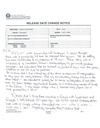
|
2023 mar 5
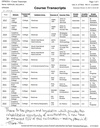
|
2023 mar 5
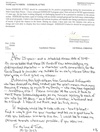
|
2023 mar 5

|
More... |


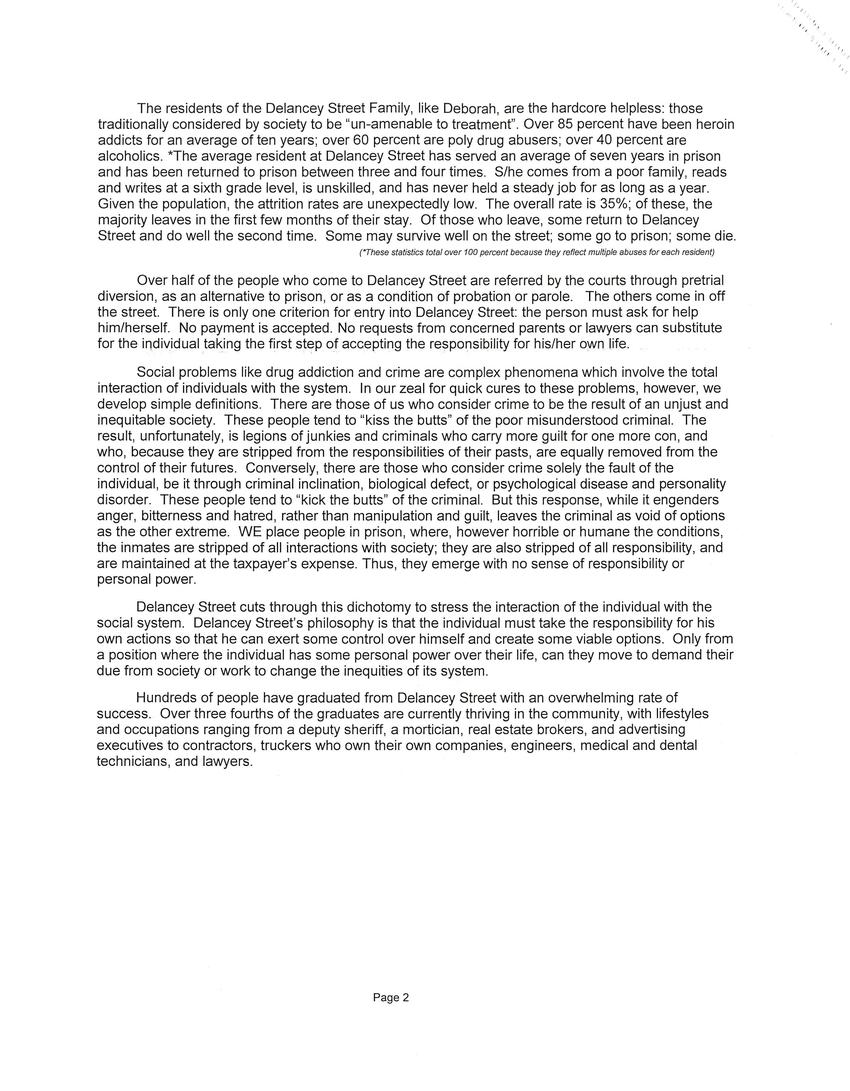


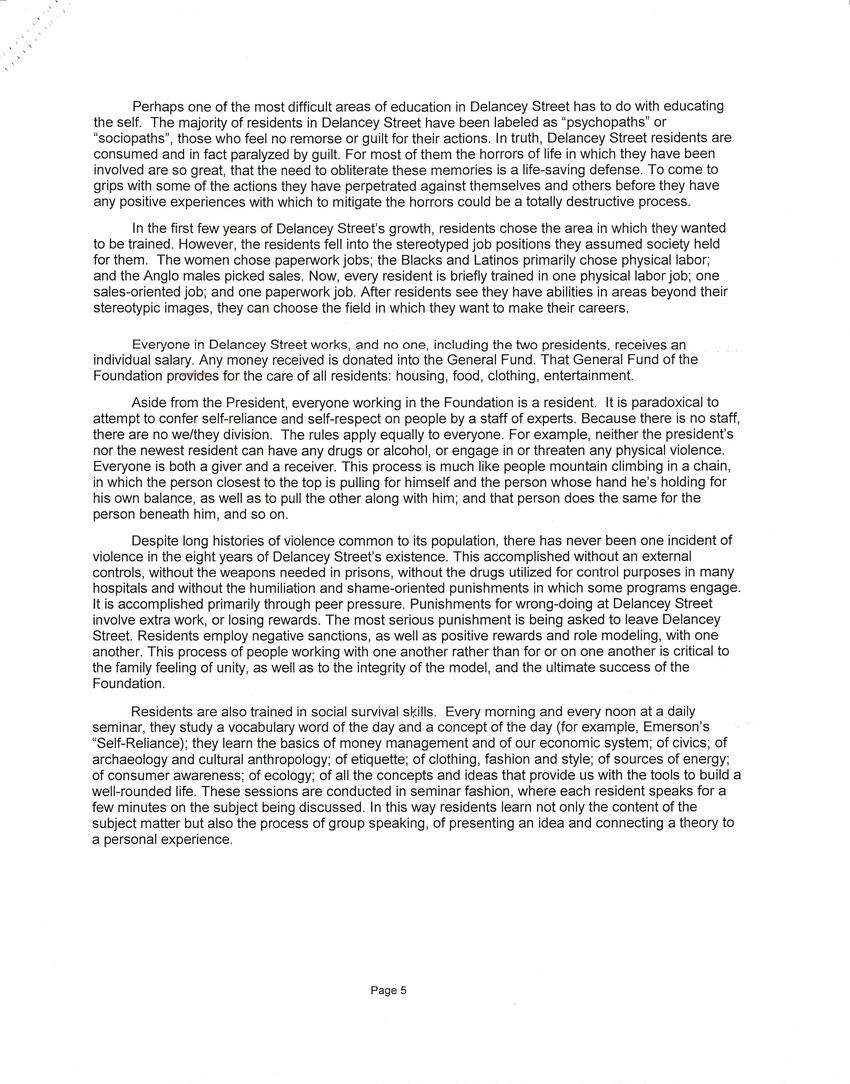
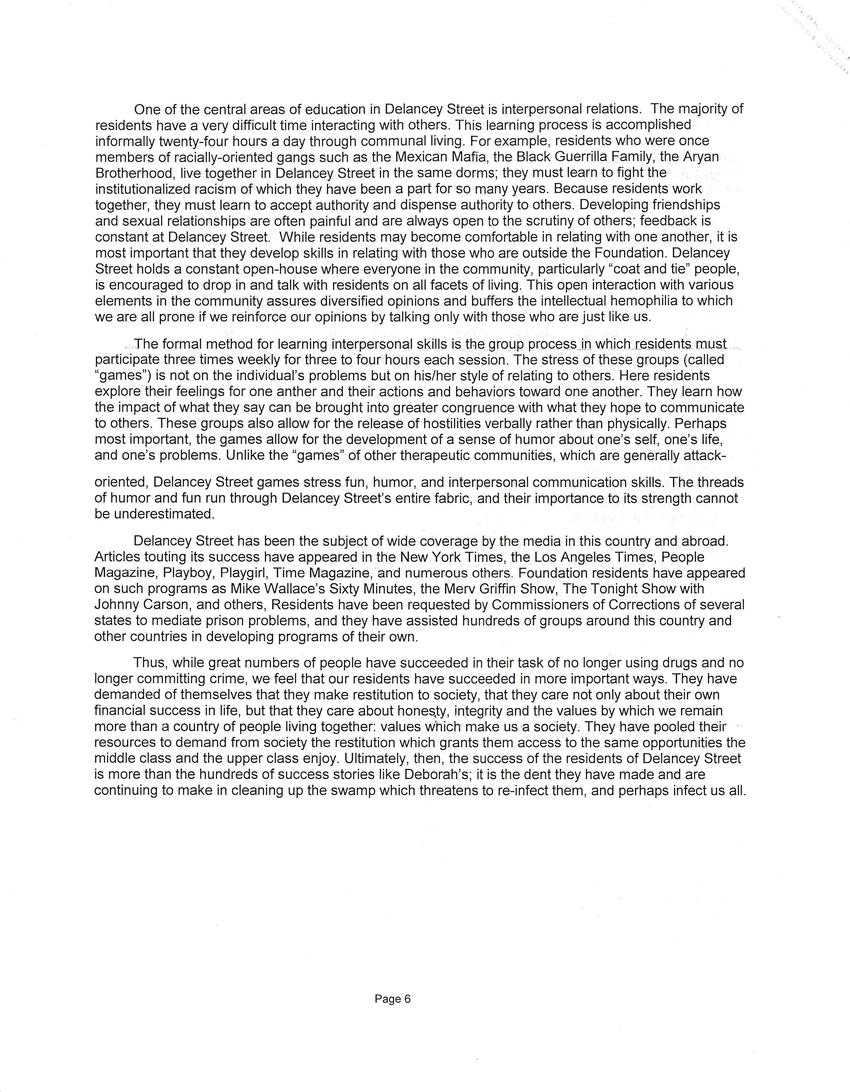

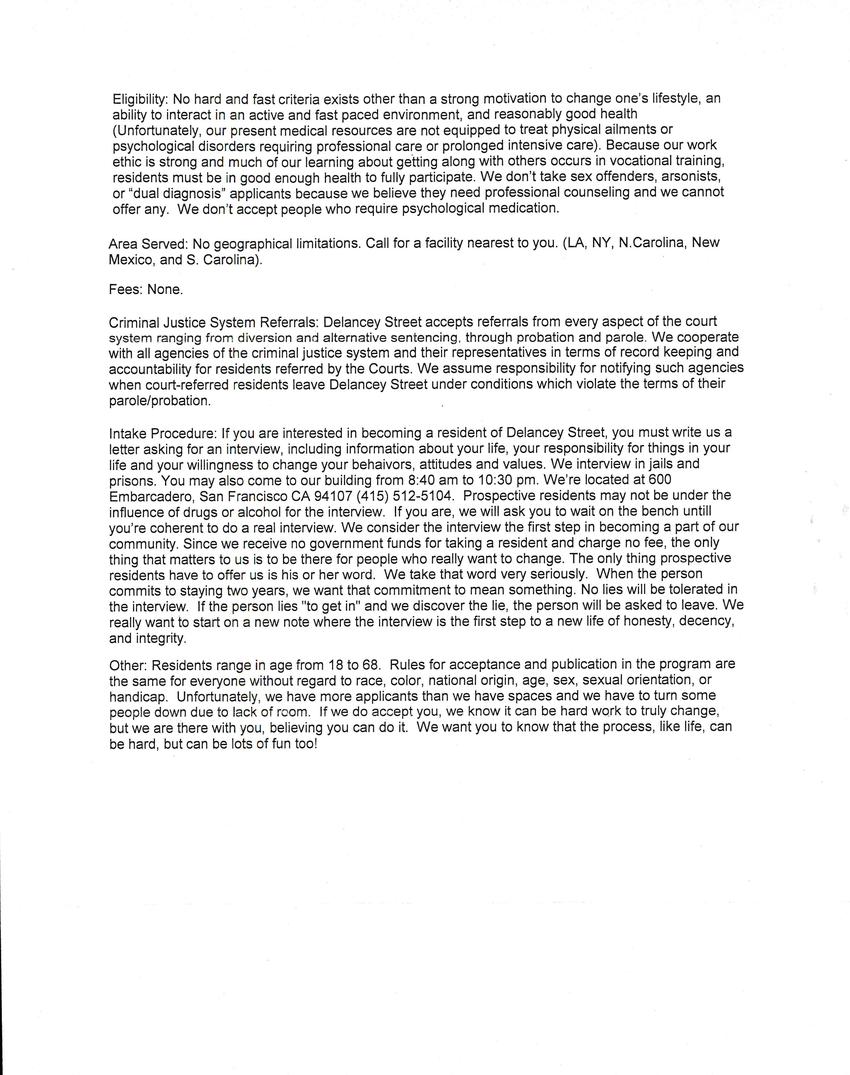

Replies